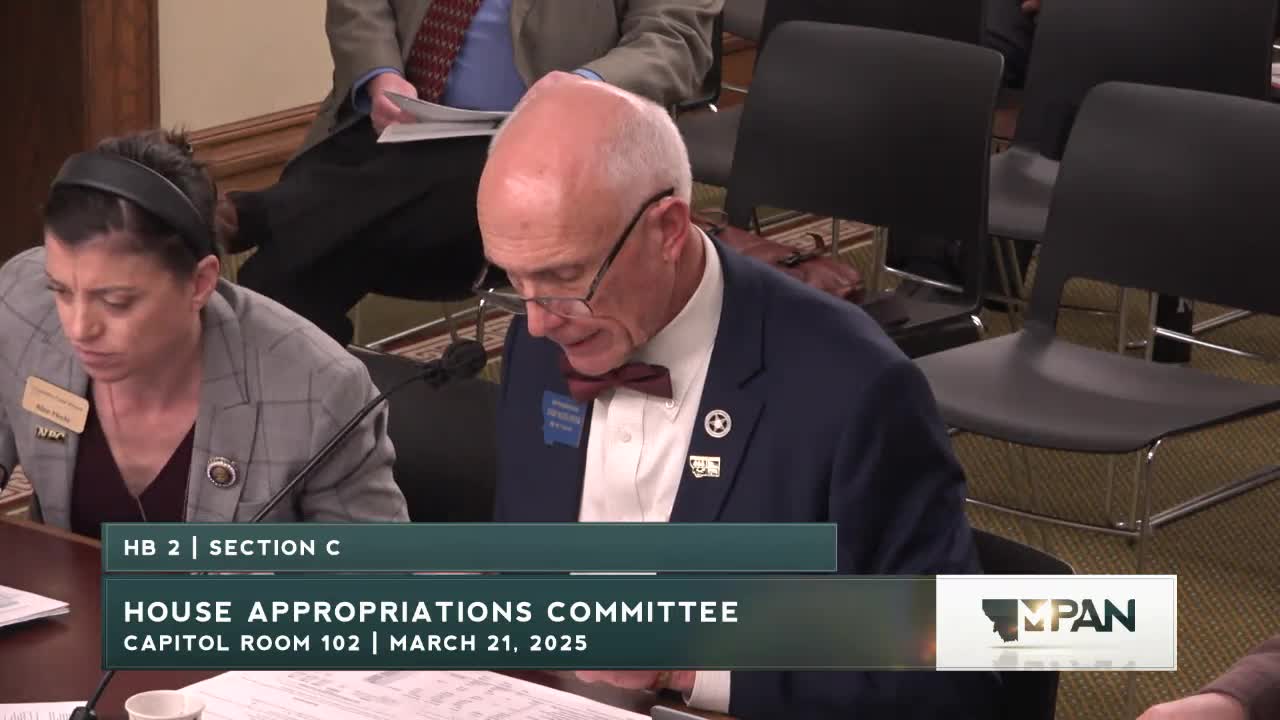Legislature approves $2.1M budget increase for animal health and meat inspection
March 21, 2025 | 2025 Legislature MT, Montana
This article was created by AI summarizing key points discussed. AI makes mistakes, so for full details and context, please refer to the video of the full meeting. Please report any errors so we can fix them. Report an error »

In a recent meeting of the Montana Legislature's House Appropriations Committee, significant budgetary decisions were made that will impact various state services, particularly in animal health and inspection. The committee approved a total budget increase of 6.4%, amounting to approximately $2.1 million above the base budget, reflecting a commitment to enhance state services amid rising operational costs.
One of the major highlights of the budget includes a one-time allocation of $1.1 million for laboratory equipment at the new facility being constructed at Montana State University (MSU). This investment aims to bolster the state's capacity for meat inspection, which is critical for maintaining food safety standards. Additionally, the meat inspection staff will see an increase of four positions, funded by an additional $628,000, to address the growing demands of the industry.
The budget also addresses the challenges faced by the animal health division, which has been impacted by a decline in the number of dairies across the state. As the number of dairies has dwindled, the revenue generated from inspection check-offs has not kept pace with the costs of maintaining these essential services. This has resulted in a shift of approximately $222,000 from federal special funds to the general fund, highlighting the need for sustainable funding solutions.
Furthermore, the committee noted that the general fund has increased by 13.5%, or $1.1 million, while state special funds rose by 6.2%, approximately $1.2 million. The latter is primarily derived from a per capita fee imposed on livestock producers, which underscores the reliance on agricultural revenue to support state services.
Despite these increases, the committee's total appropriation was $618,400 lower than the executive request, indicating a careful approach to budgeting amid fiscal constraints. The legislature also made adjustments to fixed costs, resulting in a decrease of $19,000, and did not approve all requested positions for the meat inspection staff, reflecting ongoing budgetary challenges.
As the state navigates these financial decisions, the implications for animal health and inspection services will be closely monitored, particularly as the agricultural sector continues to evolve. The next steps will involve implementing these budgetary changes and assessing their effectiveness in meeting the needs of Montana's livestock producers and ensuring public health safety.
One of the major highlights of the budget includes a one-time allocation of $1.1 million for laboratory equipment at the new facility being constructed at Montana State University (MSU). This investment aims to bolster the state's capacity for meat inspection, which is critical for maintaining food safety standards. Additionally, the meat inspection staff will see an increase of four positions, funded by an additional $628,000, to address the growing demands of the industry.
The budget also addresses the challenges faced by the animal health division, which has been impacted by a decline in the number of dairies across the state. As the number of dairies has dwindled, the revenue generated from inspection check-offs has not kept pace with the costs of maintaining these essential services. This has resulted in a shift of approximately $222,000 from federal special funds to the general fund, highlighting the need for sustainable funding solutions.
Furthermore, the committee noted that the general fund has increased by 13.5%, or $1.1 million, while state special funds rose by 6.2%, approximately $1.2 million. The latter is primarily derived from a per capita fee imposed on livestock producers, which underscores the reliance on agricultural revenue to support state services.
Despite these increases, the committee's total appropriation was $618,400 lower than the executive request, indicating a careful approach to budgeting amid fiscal constraints. The legislature also made adjustments to fixed costs, resulting in a decrease of $19,000, and did not approve all requested positions for the meat inspection staff, reflecting ongoing budgetary challenges.
As the state navigates these financial decisions, the implications for animal health and inspection services will be closely monitored, particularly as the agricultural sector continues to evolve. The next steps will involve implementing these budgetary changes and assessing their effectiveness in meeting the needs of Montana's livestock producers and ensuring public health safety.
View full meeting
This article is based on a recent meeting—watch the full video and explore the complete transcript for deeper insights into the discussion.
View full meeting
